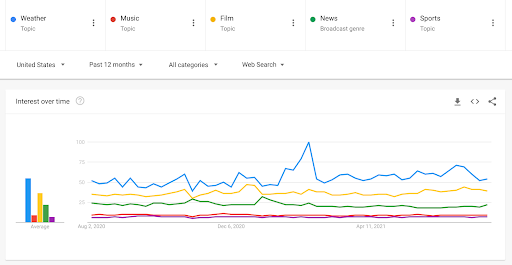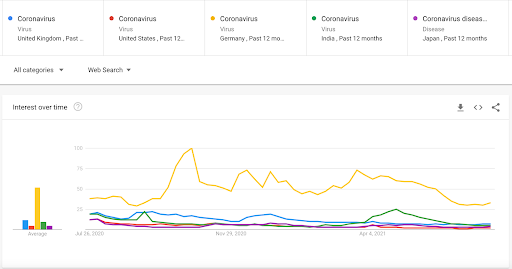To celebrate Google Trends’s 15th anniversary, we took a look at what questions about it have…well, trended. “How to use Google Trends?” and “how does Google Trends work?” were among the most-searched. So we decided to answer them with these 15 tips to help you get the most out of the tool and uncover interesting insights.
1. Data by date: Google Trends can tell you what people were searching for at any date from 2004 to a few minutes ago. It’s also based on two datasets: historic (2004-three days ago) and real-time (past week). Real-time is more granular, right down to minute-by-minute.
2. Trending versus top-searched:Trending (or rising) searches are those that are accelerating the fastest, while top-searched, or “most-searched,” are the most-searched queries in a specific time frame. Trending searches are useful for seeing how things have changed.
3. Choose topics when you can:When you start on Google Trends, you get the option to either search for a “term” or “topic.” We recommend choosing “topic” when possible. Topics are language agnostic and account for spelling variations (and mistakes!), as well as multiple names for the same thing.
5. Today’s trends: For a number of countries around the world, you can see what is trending each day. It’s also where you will get a sense of the volume of searches.
6. Find out what’s trending right now: Real-time search trends are great for seeing what’s happening in the moment and in the context of news coverage.

7. Always compare:If you want to understand the scale of a trend, use relative comparisons to gauge popularity. Weather is one of my favorite topicsto use as a point of reference. It is one of the largest and most consistently searched for topics everyday.

8. See how different places search for the same thing: This is one of my favorite hidden features of Trends. You can compare up to five topics or search terms, and for each one, you can specify the geography. For example, you can see how searches for COVID-19 varied in different countries around the world over the past 12 months.

10. Trends are not polls: Google Trends is not a tool for creating scientific polls and shouldn’t be confused with polling data. It merely reflects the search interest in particular topics during a specified duration of time.
11. …But they can tell you a lot:The Organisation for Economic Co-operation and Development (OECD) uses Trends to track GDP each week, in between its quarterly releases, to get a more granular view of what’s happening to the world’s economy.
12. Autocomplete is not the same as Trends data:Autocomplete tries to predict what you’re typing so you can get to what you’re looking for faster. But because it’s a predictive feature, we don’t want to surprise people with predictions. So even though you can search for whatever you want, we have policies for what can appear in Autocomplete. Trends, on the other hand, is a tool where you can look up search interest in any query. Because you’re typing it in and asking to see the results, we’ll show you available Trends data for almost any query.
13. See what’s Trending near you:Another interesting feature on Trends in the U.S. is the ability to see what’s been trending in a metro area without even putting in a search term. You can see what was trending over the past month, or even year. For example, here’s what wastrending in San Francisco over the past month.

14. Download your data: Just click on the download button next to each chart. For a bigger dataset, check out this new daily trending searches dataset from the Google BigQuery team.
15. And remember: Have fun with Google Trends!Around 15% of queries on Google Search each day have never been seen before. It’s a great way to peek behind the curtain at the constantly changing interests of people around the world.












